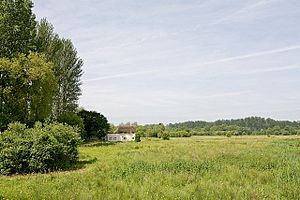Chilbolton Common facts for kids
| Site of Special Scientific Interest | |
 |
|
| Area of Search | Hampshire |
|---|---|
| Interest | Biological |
| Area | 35.5 hectares (88 acres) |
| Notification | 1987 |
| Location map | Magic Map |
Chilbolton Common is a special natural area in Chilbolton, Hampshire, England. It covers about 35.5-hectare (88-acre) of land. This site is officially known as a Site of Special Scientific Interest (SSSI) because it has unique plants and habitats.
Contents
What is Chilbolton Common?
Chilbolton Common is a protected area that includes part of the River Test and the flat land next to it, called a flood plain. This means the river sometimes overflows its banks onto this land. Because of this, the area has many different types of natural environments, which scientists call habitats.
Why is it a Special Scientific Interest?
A Site of Special Scientific Interest, or SSSI, is a place that is protected by law. These sites are chosen because they have important wildlife, plants, or geological features. Chilbolton Common is special because it has a wide variety of plants and different types of land that are important for nature.
Habitats at Chilbolton Common
The common is home to several interesting habitats, each supporting different kinds of life.
Marshy Meadows
These are wet grasslands that are often flooded or waterlogged. They are perfect for plants that love a lot of moisture.
Fen
A fen is a type of wetland that gets its water from groundwater, which is water found underground. This water is rich in minerals, which helps many special plants grow.
Willow Carr
A willow carr is a wet woodland area where willow trees are the main type of tree. These trees thrive in damp soil and create a unique forest environment.
Chalk Downland
Chalk downland is a type of grassland found on chalk hills. The soil here is thin and chalky, which means only certain types of plants can grow well. These areas are often rich in wildflowers.
Amazing Plant Life
Chilbolton Common is famous for its incredible variety of plants. More than 265 different types of flowering plants have been found here! This makes it a very important place for plant conservation.
Some of the special plants you might find include:
- Marsh arrowgrass: A small plant that grows in wet, marshy areas.
- Bog pimpernel: A delicate plant with pink flowers that likes damp, boggy ground.
- Adders-tongue fern: A small, unusual fern named for its tongue-shaped spore-bearing frond.
- Early marsh-orchid: A beautiful orchid with purple or pink flowers that grows in wet meadows.
The rich plant life at Chilbolton Common shows how important it is to protect these natural spaces. They provide homes for many species and help keep our environment healthy.

